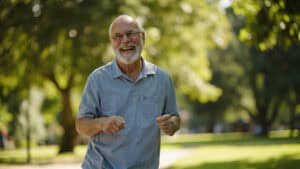Avoid These Exercises For A Bulging Disc: A Physician’s Evidence-Based Approach
Written by Dr. Matthias Wiederholz, MD – Quadruple Board-Certified in Physical Medicine, Pain Medicine, Sports Medicine, and Regenerative Medicine
Quick Insights
Avoid These Exercises For A Bulging Disc refers to steering clear of movements that stress or compress damaged spinal discs. Overloading these weakened structures can worsen pain, cause nerve irritation, and delay recovery, so expert-guided restriction is key for healing according to clinical research.
Key Takeaways
- Movements involving deep bending, twisting, or heavy lifting can aggravate a bulging disc and heighten nerve compression.
- Improper exercise selection may exacerbate herniated disc symptoms and potentially prolong recovery.
- High-impact gym activities, such as deadlifts and loaded squats, may exacerbate herniated disc symptoms and should only be performed under the guidance of a spine specialist.
- Carefully selected physical therapy and guided movement can reduce symptoms and may improve core stability with medical support.
Why It Matters
If you’re active and fear losing your lifestyle, knowing which exercises to avoid with a bulging disc can help you stay independent. Choosing the right actions now directly improves comfort, safeguards your spine, and supports a faster, more confident return to doing what you love.
As a quadruple board-certified interventional pain and regenerative medicine specialist, I bring extensive expertise to Avoid These Exercises For A Bulging Disc, combining advanced spine treatments with true compassion for how chronic pain disrupts your daily life. For patients considering innovative, minimally invasive procedures, learn more about the Discseel® procedure available at our clinic.
Avoid These Exercises For A Bulging Disc means steering clear of movements that place added strain on the spinal discs—such as deep bending, twisting, or improper lifting—which can worsen nerve compression, delay healing, and make back pain even more persistent for active people in Houston, TX. These restrictions matter because the damaged area (the disc’s annulus fibrosis and nucleus pulposus) is uniquely vulnerable to increased pressure during certain activities, often resulting in sharp symptoms or setbacks for those eager to return to sports, family life, or work.
Research demonstrates that carefully guided exercise programs are essential for disc recovery and that avoiding the wrong movements is just as critical as doing the right ones. If you’re worried about losing mobility or waiting weeks to access treatment, know that in Houston we provide minimally invasive options—like the Discseel® procedure at Performance Pain & Sports Medicine—without surgery or lengthy downtime.
To learn more about my credentials and dedication to patients, see Dr. Matthias Wiederholz’s full bio.
If you’re looking to regain your active lifestyle safely and confidently, this evidence-backed article will clarify what to avoid and how to take the next step toward lasting relief.
Discover advanced back pain treatments at our clinic.

Understanding Bulging Discs: Key Risks and Symptoms
A bulging disc—when the gel-like center (nucleus pulposus) pushes outward against the disc’s tough exterior (annulus fibrosis)—is a common reason for back pain and nerve symptoms, especially in the lower back. If not managed correctly, bulging discs can press on spinal nerves, leading to tingling, numbness, and even weakness in the legs.
Common Causes and Diagnosis
Most bulging discs develop over many years from repetitive stress (like poor posture, heavy lifting, or frequent bending and twisting). Sometimes, a single injury—such as lifting a heavy box improperly—can trigger symptoms. Diagnosis usually starts with a thorough exam and may involve imaging like MRI to confirm the disc bulge and rule out related issues.
Clinical Observation Statement:
“In my practice, I frequently encounter patients who have spent years exploring treatments—from surgeries to pain medications—without achieving meaningful relief. Often, they are unaware that minimally invasive regenerative solutions like Discseel® can effectively restore their spine health.”
Through advanced imaging and physical assessment, I tailor each plan to the exact disc and nerve involved. Early, accurate diagnosis enables a safe and effective treatment strategy—often avoiding surgery.
For more in-depth information, see our comprehensive guide to L5-S1 bulging disc.
Recognizing Worsening Signs
Your disc bulge may be worsening if you notice:
- Sharp or shooting back or leg pain
- Numbness or tingling in your arms or legs
- Weakness, clumsiness, or trouble walking
Take these signs seriously. Daily activities could exacerbate the condition if you’re not careful. Seek professional support quickly to prevent further nerve injury.
When to Seek Medical Attention
If you suddenly experience loss of bladder or bowel control, severe leg weakness, or numbness around your groin (“saddle anesthesia”), this could signal a rare but urgent nerve syndrome. Call a doctor in Houston immediately—delaying care can result in permanent nerve damage.
For further reading on related symptoms, visit emergency symptoms of a herniated disc.
Why Certain Exercises Worsen Disc Problems
Ever wonder why some movements make your back pain worse? It comes down to pressure—certain positions or loads can push more material out of a damaged disc, harming nerves and prolonging inflammation.
How Movement Impacts Disc Healing
Movements that deeply bend and twist your spine or involve heavy lifting increase internal disc pressure. This can push the disc out further, worsen pain, and delay recovery. In fact, expert guidelines from Mass General Brigham recommend avoiding heavy lifting, bending, or twisting until your disc has healed.
Professional Assessment Phrase:
“As a quadruple board-certified regenerative medicine specialist, I’ve observed that the precision of matching a patient’s spinal condition with advanced, targeted treatments like Discseel® significantly enhances their outcomes.”
Many patients I see in Houston who persist with high-risk exercises, thinking it will help, end up with longer and more intense pain flare-ups or setbacks. That’s why individualized exercise plans are an essential component of disc recovery.
Want to know more about disc tears? The guide to spinal disc tears: causes, symptoms, and treatment options.
Role of Core Strengthening
Building strong core muscles supports your spine, decreasing the risk of further disc injury. Certain core exercises may aggravate herniated disc symptoms if not selected carefully. Movements that involve forceful flexing, like sit-ups, often aggravate disc symptoms. Exercises involving significant spinal extension should be approached with caution. Research confirms that tailored physical therapy and posture correction are keys to long-term relief—not one-size-fits-all routines.
Experience-Based Insight:
“Having personally performed over 10,000 regenerative spine procedures, I’ve consistently witnessed that truly restoring function and alleviating chronic pain involves not just clinical excellence, but a deep emotional and functional understanding of each patient’s needs.”
Explore more about herniated disc exercises and which might be suitable during your recovery.

Top Exercises and Movements to Avoid with a Bulging Disc
Direct Answer:
Avoid These Exercises For A Bulging Disc to protect healing and prevent nerve irritation. Clinical evidence indicates that specific movements may worsen herniated disc symptoms and potentially impede recovery.¹
Unsafe Movements Checklist:
- Deep forward bends (e.g., toe touches, sit-ups)
- Twisting motions (e.g., Russian twists, golf swings)
- Heavy or loaded lifting (deadlifts, barbell squats)
- High-impact activity (jumping, running)
- Overhead presses and back hyperextensions
These movements place significant stress on the disc, potentially exacerbating herniation or compressing sensitive nerves. A recent meta-analysis showed that improper exercise selection actually worsens herniation and delays recovery.
For those seeking more on lumbar disc injuries, check out effective treatment options for L5-S1 disc herniation pain.
Dangerous Gym Activities
Certain gym-based exercises, such as barbell or kettlebell deadlifts, weighted squats, and leg presses, may exacerbate bulging disc symptoms. Exercises involving back extension machines, ‘Superman,’ or reverse-hyper movements should be approached with caution.
As per recent studies on disc degeneration, poor posture during exercise further increases damage risk. Many local patients are surprised to hear that improper spine posture during common machine exercises or classes may exacerbate herniated disc symptoms.
Clinical Observation Statement:
“In my clinic, I’ve guided many Houston athletes and weekend warriors who unintentionally worsened their symptoms by sticking with high-risk exercises. Once we adjust their program, relief comes much faster.”
Supplement your understanding by reading what is disc desiccation?
Is It Safe to Do Squats with a Bulging Disc?
Generally, no—standard squats can increase spinal compression and should be performed only if your physician has cleared you for a modified version. Improper form during bodyweight squats can place undue stress on your discs and nerves.
Comparative Expertise:
“Unlike larger clinics where patients may rarely see the same provider, I personally oversee every aspect of each patient’s care—from detailed diagnostics to recovery and rehabilitation—to ensure they feel heard, supported, and truly understood.”
If you’re eager to keep squatting, you must be evaluated by a spine specialist with expertise in rehabilitation. Most people with a fresh or symptomatic disc bulge are safer focusing on recovery movements until cleared.
Key Research Insight:
Exercise therapy is effective for bulging discs when movements are carefully selected—one meta-analysis found targeted exercise can ease pain and build core muscle safely when high-risk moves are excluded.
Find more on L5-S1 pain: causes, symptoms, and treatment.

Recommended Safe Activities for Recovery
Movement is still essential—but it must be gentle, deliberate, and personalized to avoid setbacks. What you do matters as much as what you avoid.
Guided Physical Therapy
Physical therapy is the bedrock of safe, effective disc recovery. Your Houston-based provider will create a gentle progression focused on stretching, core stability, and posture correction. Multiple systematic reviews confirm that light exercise and professional-guided rehab are preferred over bedrest or inactivity for bulging discs.
Experience-Based Insight:
“In my Houston and New Jersey clinics, I’ve found that a professionally supervised program—as opposed to generic online routines—minimizes risk and maximizes functional gains. Every exercise must match the stage of your recovery.”
To explore related options, review treatments for disc desiccation.
Low-Impact Alternatives
Safe movement strategies for bulging disc recovery include:
- Gentle walking on flat ground
- Swimming or water aerobics (buoyancy reduces spine pressure)
- Stationary cycling (with upright posture)
- Yoga or Pilates—with close attention to form and modifications
- “Williams back exercises,” which deliberately avoid deep lumbar extension
Evidence-Based Note:
These techniques (Williams back exercises specifically) are endorsed for disc problems because they limit extension-related disc pressure. They’re well-supported by research and widely used for non-surgical care.²
Do not try to “push through the pain”—listen to your body and get expert confirmation before increasing activity.
Pro Tip:
Use a checklist or follow your therapist’s progression to ensure every new move is safe for your spine.
Need tips on managing symptoms? Read about managing lumbar degenerative disc disease.

How the Discseel® Procedure Offers Hope
If you’ve tried conservative care and still struggle with bulging disc symptoms, the Discseel® Procedure offers a revolutionary, non-surgical path to healing—available exclusively in the Houston region at Performance Pain & Sports Medicine.
This outpatient procedure uses a biologic fibrin sealant to repair the annulus fibrosis (the torn disc wall) and stimulate natural collagen regrowth. Unlike invasive surgeries, there are no incisions, hardware, or hospital stays.
Benefits Over Traditional Spine Surgery
Discseel® stands apart from conventional fusions or discectomies:
- No incisions or implanted hardware
- Outpatient, minimally invasive—most return to activity in days
- Preserves your natural spinal mobility
- 82% documented success rate—much higher than fusion’s 31% average
- Faster recovery: fewer restrictions on post-procedure bending, lifting, or twisting compared to most surgeries³
Professional Assessment Phrase:
“As a quadruple board-certified regenerative spine specialist, my advanced training by Discseel® inventor Dr. Kevin Pauza means Houston patients access the very latest in biological repair—restoring, rather than removing or replacing, the disc tissue.”
Many patients who previously faced months of post-surgical restrictions are able to return to their favorite workouts and hobbies—often within weeks.
Want real-world perspectives? Read Discseel® reviews: Achieving lasting back pain relief.
Local patient outcomes in Houston TX:
At Performance Pain & Sports Medicine, I personally oversee every Discseel® case—ensuring you are empowered, informed, and on track for restored mobility. Patients consistently report rapid return to sports, work, and family life without the risks of hospital-based surgery.
For local treatment, see our Houston clinic details here.
Expert Spine Care in Houston, TX: Why Choose Dr. Matthias Wiederholz?
Your care experience matters—especially when it’s your spine. Houston deserves a practice that combines clinical leadership, cutting-edge solutions, and compassion for your real-life goals.
Credentials and Expertise
I am Houston’s only quadruple board-certified spine specialist who is also a certified Master Instructor for the Discseel® Procedure—trained directly by its inventor. Nationally, I have performed over 10,000 regenerative interventions and trained other physicians in minimally invasive disc repair.
Comparative Expertise:
“Unlike larger clinics where patients may rarely see the same provider, I personally oversee every aspect of each patient’s care—from diagnostics through recovery—so they always feel heard, supported, and truly understood.”
Get more insight into disc desiccation: understanding the causes, symptoms, and treatment.
Personalized Regenerative Treatment
Whether you seek advanced minimally invasive therapies (like Discseel® or the Superion® Interspinous Spacer), or need expert, conservative management, my boutique Houston clinic provides:
- Personal, consistent attention each visit
- Tailored recovery plans—no “cookie-cutter” regimens
- Comprehensive coaching on home exercise, ergonomics, and long-term wellness
My team and I are committed to helping you avoid unnecessary surgery and empowering you with real options to reclaim your life.

What Our Patients Say on Google
Patient experiences are at the heart of my approach to spine care. Hearing directly from those I’ve treated helps me continually refine and personalize every aspect of the patient journey.
I recently received feedback that captures what we aim to provide for every individual seeking relief from spine pain and dysfunction:
“Dr. Wiederholz and the entire team at OSD Surgery Center were amazing. Dr. Wiederholz gave me cervical spinal injections for pain relief. The entire process from check-in until when I was discharged was a good experience. The entire team was kind and caring and made me feel safe and secure. I will be going back in 4 weeks for the same procedure on my lower spine. I highly recommend Dr. Wiederholz and his team for pain management procedures. I would recommend him to anyone.”
— Brenda
Read more Google reviews here
This feedback illustrates our commitment to safety, compassion, and effective pain management. It’s a privilege to help patients in Houston regain comfort and confidence—especially when facing the challenges of a bulging disc.
Avoid These Exercises For A Bulging Disc in Houston, TX
Living with a bulging disc in Houston, TX means navigating not only your symptoms but also the unique demands of our active, fast-paced city. Many of my patients here are eager to return to work, sports, or family activities as quickly as possible, making safe exercise guidance especially important.
Houston’s climate and lifestyle often encourage year-round activity, but this can also increase the risk of aggravating a disc injury if the wrong movements are chosen. That’s why I emphasize a personalized approach—tailoring every recovery plan to your specific needs and the realities of daily life in our community.
At Performance Pain & Sports Medicine, we offer advanced, minimally invasive options like the Discseel® Procedure right here in Houston. Our clinic is dedicated to helping local residents avoid unnecessary surgery and get back to what they love, safely and confidently.
If you’re in Houston and struggling with a bulging disc, I invite you to schedule a consultation. Let’s create a plan that protects your spine and supports your active lifestyle—so you can move forward with less pain and more freedom.
Conclusion
Avoid These Exercises For A Bulging Disc is essential if you want to protect your spine, reduce pain, and get back to the activities you love. By steering clear of high-risk movements and following a personalized, evidence-based plan, you can prevent setbacks and support true healing. My advanced regenerative treatments—like Discseel®—help patients in Houston, TX reclaim their mobility and quality of life, often without surgery or long recovery times. As a quadruple board-certified spine specialist, I am dedicated to providing compassionate, one-on-one care that addresses both your physical symptoms and your emotional well-being.
If you’re ready to stop missing out on family events or daily activities due to chronic back pain, I invite you to take the next step. See if you are a candidate for the Discseel® Procedure by visiting this quick assessment link. Early regenerative intervention leads to better outcomes—let’s help you reclaim your life.
This article is for educational purposes only and should not be used as a substitute for professional medical advice, diagnosis, or treatment. Always seek the advice of your physician or other qualified healthcare provider with any questions you may have regarding a medical condition or treatment options. Never disregard professional medical advice or delay in seeking it because of something you have read in this article.
Frequently Asked Questions
What exercises should I avoid with a bulging disc?
You should avoid deep forward bends, twisting motions, heavy lifting (like deadlifts and squats), high-impact activities, and exercises that extend your lower back. These movements can increase disc pressure and worsen symptoms. A tailored plan from a spine specialist is the safest way to protect your recovery.
Where can I find advanced, non-surgical spine care in Houston, TX?
You can find advanced, non-surgical spine care—including the Discseel® Procedure—at my practice, Performance Pain & Sports Medicine in Houston, TX. I offer prompt appointments and personalized treatment plans to help you return to your active lifestyle safely and confidently.
How do you help patients who have “tried everything” for chronic disc pain?
I specialize in helping patients who haven’t found relief with standard treatments. My approach combines thorough diagnosis, advanced regenerative options like Discseel®, and hands-on guidance. Many patients experience significant improvement—even after years of pain—by following a plan tailored to their unique needs.
References
1. Clinical research on exercise for disc recovery
2. Williams back exercises for non-surgical care
3. Discseel® success rates comparison

















